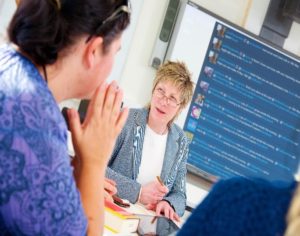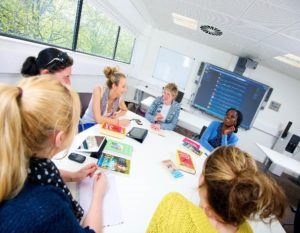Consciously Connecting and Proactively Collaborating: The CoActEd Learner Mapping Tool in #SocWorkEd

Editor’s Note: Amanda Taylor-Beswick is a Senior Lecturer in the School of Social Work, Care and Community at the University of Central Lancashire. She is also an author of the book, The LearningWheel Book, whichprovides educators with a model for helping students and practitioners develop digital literacy skills. In this blog post, Amanda describes one of the tools from her book, the CoActEd Learner Mapping Tool. She tweets at @AMLTaylor66.
From the moment a social work student steps into the educational environment, they are engaged in a socialising process that involves exposure to, familiarisation with, and the development of professional norms. Through this carefully crafted learning experience a student’s Professional Learning Network (PLN), amongst other things, begins to form; professional relationships with academics, with practice partners, with practitioners and with student peers are built. This professional network is primarily local, largely institutional and generally geographically bound. However, digitisation means that the professional network no longer needs to be so rigid, so limited or so confined. The availability and affordances of social technologies (those that are #GDPR compliant) offer opportunities for social work students to connect outside of their direct or more natural community of learning. They can engage with the global social work community which, in previous times, may have been out of reach. The use of a medium through which to map and to therefore build connections forms the basis of this blog.
The medium being referred to is that of the CoActEd Learner Mapping Tool. The idea for the CoActEd Learner tool emerged through the writing of ‘The LearningWheel Book’ (Kellsey & Taylor, 2016). The LearningWheel, originally designed by Kellsey, was developed to equip educators with a context in which to appraise digital tools; to identify those that both develop digital literacies and support learning gain. It was when sketching out Chapter 3, the section of the book that deals with collaboration, that the idea of the CoActEd Learner arose. The Co in CoActEd – representing ‘Connection’ and ‘Collaboration’; the Act in CoActEd – representing ‘Activity’ and ‘Action’; and the Ed in CoActEd – representing the ‘Education’ context. The composite parts of the CoActEd Learner Mapping Tool together form an educational tool designed to ‘consciously’ chart and to ‘proactively’ engage in the development of a PLN; a network that can support the educational journey, as linked to the professional career.
The initial iteration of the tool was disseminated via ‘The LearningWheel’ book mentioned above. However, since that time I have worked with an educational developer, Laura Ridings from the University of Central Lancashire TELT Team, to make the mapping tool even more accessible to educators, to practitioners and to student groups. Whilst not specific to social work, the tool can be used in social work education, given how it prompts learners to think about who and what can support their learning and professional development as they work towards qualification. The mapping exercise encourages students to consciously and proactively seek out opportunities to connect and collaborate, and to take up their place within an ever-growing professional sphere.
Informal feedback, gathered from students, educators and practice partners, regarding the experience of using the tool has been positive. The following comments provide a flavor of the impact of embedding the tool into education and practice contexts:
‘I’d never thought about being part of the profession in this way’ (social work student)

‘This is great for working with young people who sometimes need help with planning careers too’ (social work practitioner)
‘Students have not only mapped out their network, but also connected with the need to be online’ (social work educator)
‘I’ve used it to map out my own PLN. I really wasn’t that connected before and was most definitely not online’ (social work educator)
‘I’m now using this for student group supervision and as part of practitioner induction into the workplace’ (social work practitioner)
‘Wish I’d had this in my first year’ (social work student)
I would urge educators, students and practitioners to have a go; to see where and to whom the mapping tool leads you. Below is a capture of the first CoActEd Learner Mapping exercise I completed. I most likely need to review this, to make sure that my map reflects my current PLN needs. It might be interesting for colleagues, students and practitioners to share their completed CoActEd Learner Map in the comments box below or on Twitter using the #CoActEdLearner hashtag – adding @amltaylor66 and @laurelhitchcock into your tweet.

References:
Kellsey, D., & Taylor, A. (2016). The LearningWheel: A Model of Digital Pedagogy. St Albans, England: Critical Publishing.
How to cite this post:
Taylor-Beswick, A. (2019, June 12). Consciously Connecting and Proactively Collaborating: The CoActEd Learner Mapping Tool in Social Work Education [Blog Post]. Retrieved from: https://laureliversonhitchcock.org/2019/06/11/consciously-connecting-and-proactively-collaborating-the-coacted-learner-mapping-tool-in-socworked/


